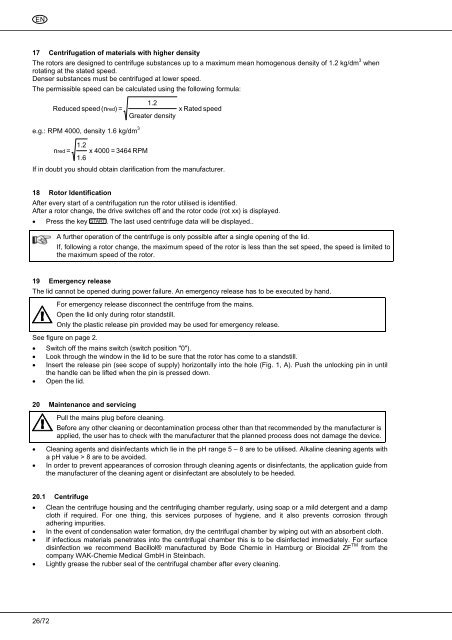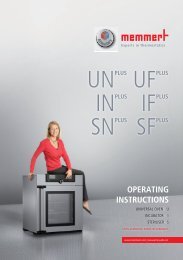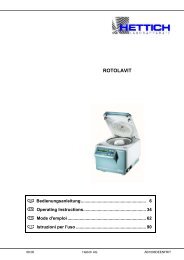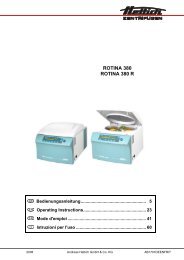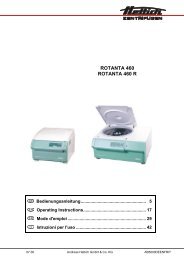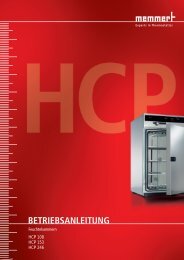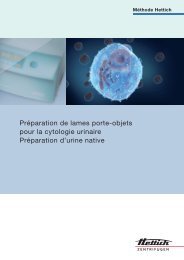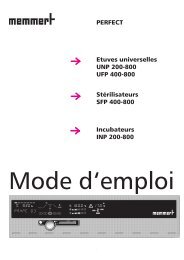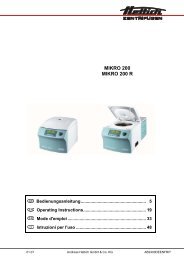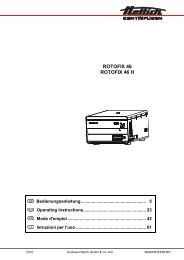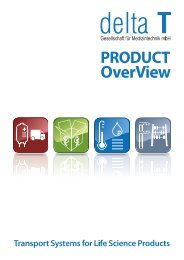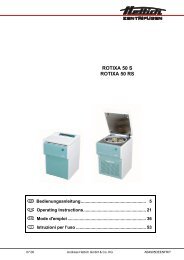ROTOFIX 32 A - Hettich AG, CH
ROTOFIX 32 A - Hettich AG, CH
ROTOFIX 32 A - Hettich AG, CH
Create successful ePaper yourself
Turn your PDF publications into a flip-book with our unique Google optimized e-Paper software.
EN<br />
17 Centrifugation of materials with higher density<br />
The rotors are designed to centrifuge substances up to a maximum mean homogenous density of 1.2 kg/dm 3 when<br />
rotating at the stated speed.<br />
Denser substances must be centrifuged at lower speed.<br />
The permissible speed can be calculated using the following formula:<br />
26/72<br />
Reduced speed<br />
(n<br />
red<br />
) =<br />
e.g.: RPM 4000, density 1.6 kg/dm 3<br />
nred =<br />
1.2<br />
x 4000 = 3464 RPM<br />
1.6<br />
1.2<br />
x Rated speed<br />
Greater density<br />
If in doubt you should obtain clarification from the manufacturer.<br />
18 Rotor Identification<br />
After every start of a centrifugation run the rotor utilised is identified.<br />
After a rotor change, the drive switches off and the rotor code (rot xx) is displayed.<br />
• Press the key START . The last used centrifuge data will be displayed..<br />
A further operation of the centrifuge is only possible after a single opening of the lid.<br />
If, following a rotor change, the maximum speed of the rotor is less than the set speed, the speed is limited to<br />
the maximum speed of the rotor.<br />
19 Emergency release<br />
The lid cannot be opened during power failure. An emergency release has to be executed by hand.<br />
For emergency release disconnect the centrifuge from the mains.<br />
Open the lid only during rotor standstill.<br />
Only the plastic release pin provided may be used for emergency release.<br />
See figure on page 2.<br />
• Switch off the mains switch (switch position "0").<br />
• Look through the window in the lid to be sure that the rotor has come to a standstill.<br />
• Insert the release pin (see scope of supply) horizontally into the hole (Fig. 1, A). Push the unlocking pin in until<br />
the handle can be lifted when the pin is pressed down.<br />
• Open the lid.<br />
20 Maintenance and servicing<br />
Pull the mains plug before cleaning.<br />
Before any other cleaning or decontamination process other than that recommended by the manufacturer is<br />
applied, the user has to check with the manufacturer that the planned process does not damage the device.<br />
• Cleaning agents and disinfectants which lie in the pH range 5 – 8 are to be utilised. Alkaline cleaning agents with<br />
a pH value > 8 are to be avoided.<br />
• In order to prevent appearances of corrosion through cleaning agents or disinfectants, the application guide from<br />
the manufacturer of the cleaning agent or disinfectant are absolutely to be heeded.<br />
20.1 Centrifuge<br />
• Clean the centrifuge housing and the centrifuging chamber regularly, using soap or a mild detergent and a damp<br />
cloth if required. For one thing, this services purposes of hygiene, and it also prevents corrosion through<br />
adhering impurities.<br />
• In the event of condensation water formation, dry the centrifugal chamber by wiping out with an absorbent cloth.<br />
• If infectious materials penetrates into the centrifugal chamber this is to be disinfected immediately. For surface<br />
disinfection we recommend Bacillol® manufactured by Bode Chemie in Hamburg or Biocidal ZF TM from the<br />
company WAK-Chemie Medical GmbH in Steinbach.<br />
• Lightly grease the rubber seal of the centrifugal chamber after every cleaning.


